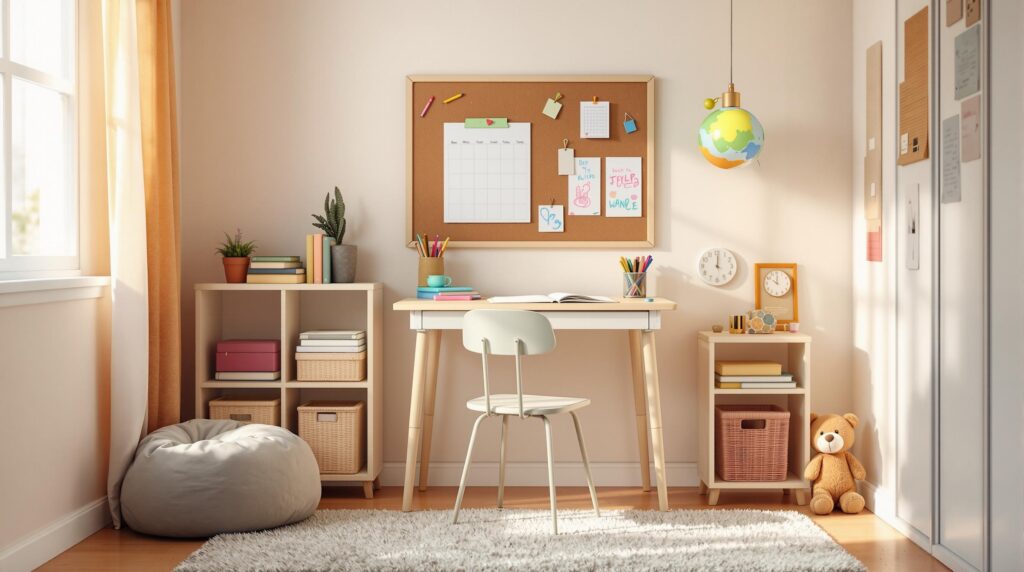Table of Contents
ToggleEstablishing an effective homework routine for your child is a crucial step in supporting their academic growth and overall development. As a parent, you play a vital role in creating an environment that fosters learning, independence, and success. Let’s explore how you can craft a homework routine that’s tailored to your child’s unique needs and learning style.
Understanding Your Child’s Development and Homework Readiness
Before diving into creating a homework routine, it’s essential to understand your child’s developmental stage and readiness for academic tasks. Children progress through distinct cognitive development stages, as outlined in Jean Piaget’s theory:
- Sensorimotor stage (birth to 18-24 months): Children learn through sensory experiences and manipulating objects.
- Preoperational stage (2-7 years): Children begin to think symbolically and learn to use words and pictures to represent objects.
- Concrete operational stage (7-11 years): Children start to think logically about concrete events.
- Formal operational stage (adolescence to adulthood): Abstract thinking and complex reasoning develop.
Alongside these cognitive stages, children also reach various developmental milestones in gross motor, fine motor, communication, cognitive, and social-emotional skills. For instance, by age 5, most children can catch a ball, balance on one foot, draw simple shapes, and recall parts of a story. Understanding these milestones can help you gauge your child’s readiness for different types of homework tasks.

The Importance of Routine and Consistency in Homework
Establishing a consistent homework routine is key to your child’s academic success. Regular routines develop a sense of security and predictability for children, which can significantly reduce stress and improve focus. The NICHD Study of Early Child Care and Youth Development found that consistent care environments positively impact children’s cognitive and social development.
A well-structured homework routine helps children:
- Develop time management skills
- Build discipline and responsibility
- Improve concentration and memory retention
- Reduce anxiety associated with schoolwork
To create consistency, set a specific time each day for homework. This could be right after school or after a short break, depending on your child’s energy levels and preferences. Stick to this schedule as much as possible, even on days when there’s less homework, using the extra time for reading or educational activities.
Creating a User-Friendly Homework Environment
The physical space where your child does homework can significantly impact their focus and productivity. Here are some tips for creating an ideal homework environment:
Minimize Distractions
Choose a quiet area away from TVs, noisy siblings, or high-traffic areas of your home. If possible, designate a specific spot solely for homework to help your child mentally associate that space with learning and focus.
Ensure Good Lighting
Proper lighting reduces eye strain and helps maintain alertness. Natural light is ideal, but if that’s not possible, use a desk lamp that provides even, glare-free illumination.
Use Appropriate Furniture
Ensure your child has a comfortable chair and a desk or table at the right height. Their feet should be able to rest flat on the floor, and the desk should be at elbow height when they’re seated.
Organize the Workspace
Keep the area tidy and well-organized. Have all necessary supplies (pencils, paper, calculator, etc.) easily accessible. Use organizers or containers to reduce clutter and help your child find what they need quickly.
For written materials, use 12-point or larger font to reduce eye strain. If your child is working on a computer, adjust the screen settings for comfort and consider using blue light filters to reduce eye fatigue.
Tailoring the Homework Routine to Your Child’s Needs
Every child has unique learning styles and preferences. Creating a homework routine that works for your child involves understanding and accommodating these individual needs.
Identify Your Child’s Learning Style
Observe how your child learns best. Are they visual learners who benefit from charts and diagrams? Auditory learners who prefer verbal explanations? Or kinesthetic learners who learn through hands-on activities? Once you’ve identified their learning style, you can incorporate appropriate strategies into their homework routine.
Consider Your Child’s Energy Levels
Some children are most alert right after school, while others need time to unwind. Pay attention to when your child seems most focused and schedule homework time accordingly.
Break Tasks into Manageable Chunks
If your child struggles with long assignments, break them into smaller, more manageable parts. This can help prevent overwhelm and maintain motivation.
Incorporate Movement Breaks
For children who have difficulty sitting still, incorporate short movement breaks between tasks. This could be a quick stretch, a walk around the room, or a few jumping jacks.
The Role of Parental Involvement and Support
Active parental engagement is crucial for an effective homework routine. The NICHD Study found a strong correlation between parental involvement and better academic outcomes. However, it’s important to strike a balance between support and independence.
Be Available, But Not Overbearing
Let your child know you’re available to help if needed, but avoid hovering. Encourage them to attempt problems on their own before asking for assistance.
Provide Guidance, Not Answers
When your child asks for help, guide them towards the solution rather than providing the answer. Ask leading questions that help them think through the problem.
Communicate with Teachers
Regular communication with your child’s teachers can help you understand their expectations and any areas where your child might need extra support. Knowing how much help is appropriate can prevent over-involvement that might hinder your child’s learning.
Encouraging Independence in Homework Completion
Gradually increasing your child’s independence in completing homework builds confidence and self-reliance. The NICHD Study highlights the importance of this gradual independence in child development.
Start Small
Begin by letting your child choose the order in which they complete their tasks. This small decision-making opportunity can foster a sense of control and responsibility.
Use a Timer
Set a timer for short periods (e.g., 15 minutes) during which your child works independently. Gradually increase this time as they become more comfortable.
Create a Checklist
Help your child create a checklist of tasks they need to complete. This visual aid can help them stay organized and track their progress independently.
Using Positive Reinforcement to Motivate
Positive reinforcement can be a powerful tool in encouraging adherence to a homework routine. Consistent use of praise and rewards can improve behavior and academic performance.
Verbal Praise
Offer specific praise for effort and improvement, not just results. For example, “I’m proud of how you kept trying even when that math problem was difficult.”
Reward Systems
Consider implementing a sticker chart or point system for completing homework tasks. These can be exchanged for small rewards or privileges.
Celebrate Milestones
Acknowledge when your child reaches important homework milestones, such as completing a challenging project or maintaining their routine for a full month.
Monitoring Progress and Adjusting the Routine
Regularly reviewing your child’s homework performance and making necessary adjustments is crucial for maintaining an effective routine. This aligns with the concept of developmental surveillance – monitoring a child’s development over time.
Regular Check-ins
Schedule weekly check-ins with your child to discuss how the homework routine is working. Are they feeling overwhelmed? Are certain subjects particularly challenging?
Adjust as Needed
Be prepared to modify the routine based on your observations and your child’s feedback. This might involve changing the timing, altering the task types, or adjusting the level of support you provide.
Track Progress
Keep a log of your child’s homework completion and grades. This can help you identify patterns and areas that might need additional attention.
Balancing Homework with Other Activities
Managing homework effectively involves ensuring it doesn’t lead to excessive stress or imbalance in your child’s life. It’s crucial to maintain time for physical activity, social interaction, and relaxation.
Set Time Limits
Establish reasonable time limits for homework based on your child’s age and grade level. If homework consistently exceeds these limits, discuss this with your child’s teacher.
Prioritize Physical Activity
Ensure your child has time for physical play or organized sports. Physical activity can improve focus and cognitive function, benefiting homework performance.
Allow for Downtime
Make sure your child has unstructured time to relax, play, and pursue their interests. This balance is essential for overall well-being and can prevent burnout.
Encourage Creativity
Fostering creativity in your child can enhance their problem-solving skills and make homework more engaging. Incorporate creative activities into their routine, such as drawing, storytelling, or building projects related to their studies.
By implementing these strategies and understanding the importance of routines, you can create a homework environment that supports your child’s learning, builds their confidence, and sets them up for academic success. Remember, the key is to remain flexible and responsive to your child’s changing needs as they grow and develop.
Sources:
Jean Piaget’s Stages of Cognitive Development
Evidence-based milestone ages as a framework for developmental surveillance
The NICHD Study of Early Child Care and Youth Development












